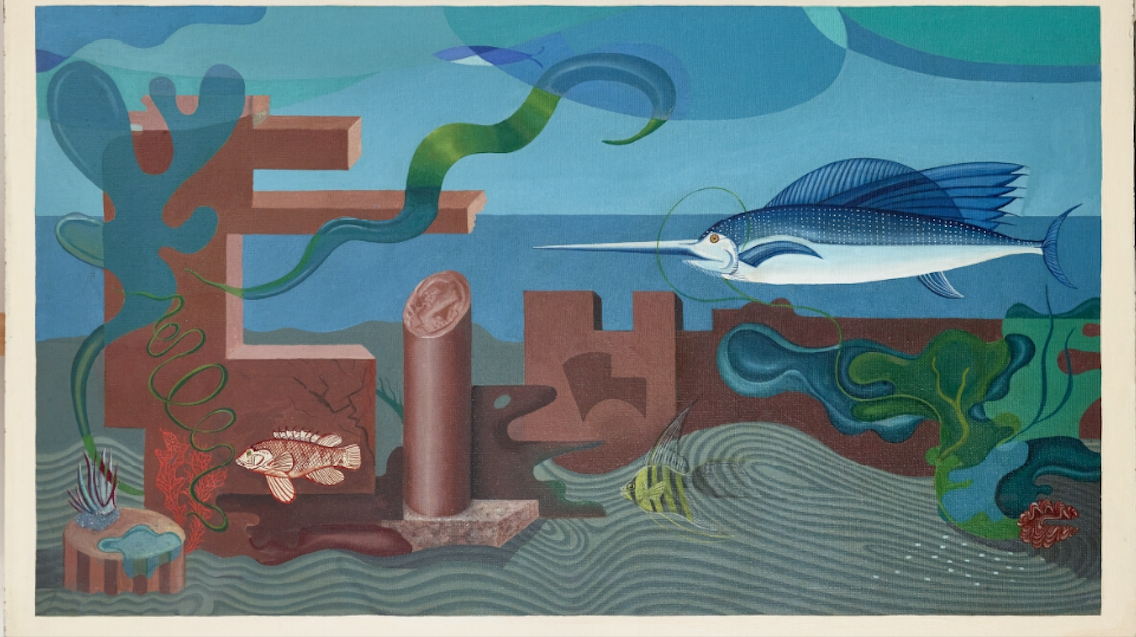23 septembre 2021 - 17 h 30 min - 19 h 30 min


- Terra Foundation for American Art Center,
- Conference Room, 121 rue de Lille, 75007 Paris
- Thursday 5.30 – 7.30 pm
Atlantis, pre-Columbian “Mound Builders,” cave men locked in combat with T. Rex; visions of ancient, ruined, or “lost” worlds on a spectrum between fact and fantasy have long fascinated American artists and producers of visual culture. From the moment of contact between indigenous Americans and people from what became the “Old World,” the Americas posed a problem for established stories about the deep past. Over the course of the nineteenth and twentieth centuries, developments in both the sciences and popular culture accelerated a process in which various “old” and “lost” worlds were invented to make sense of and imagine the new. These worlds might be at the bottom of the ocean, buried underground, or lost in jungles, but they could be brought back via the image.
In this course, we will ask how U.S. artists and image-makers from the eighteenth century to the present have depicted prehistory, and to what ends. Probing the relationships between production, circulation, and reception, as well as between image, media, and form, we will consider artists such as Thomas Cole, Charles R. Knight, Walker Evans, Archibald Motley Jr., Louise Janin, Hilaire Hiler, Robert Smithson, and Stephen Spielberg, among others. By the seminar’s end, we will have a deeper understanding of how U.S. visualizations of prehistory have contributed to new concepts of culture, time, and space.
Abbreviated Bibliography:
- Buck-Morss, Susan. The Dialectics of Seeing: Walter Benjamin and the Arcades Project. Cambridge: The MIT Press, 1989.
- Miller, Angela. “‘The Soil of an Unknown America’: New World Lost Empires and the Debate over Cultural Origins.” American Art, Summer-Autumn, 1994, Vol. 8, No. ¾.
- Mitchell, W.J.T. The Last Dinosaur Book: The Life and Times of a Cultural Icon. Chicago: University of Chicago Press, 1998.
- Mooney, Amy M. “Representing Race: Disjunctures in the Work of Archibald J. Motley, Jr.” Art Institute of Chicago Museum Studies, Vol. 24, No. 2, 1999.
- Orvell, Miles. Empire of Ruins: American Culture, Photography, and the Spectacle of Destruction. New York: Oxford University Press, 2021.
- Pillsbury, Joanne. Past Presented: Archaeological Illustration and the Ancient Americas. Washington DC: Dumbarton Oaks, 2012.
- Truettner, William H. and Allan Wallach, eds. Thomas Cole: Landscape into History. New Haven: Yale University Press, 1994.
Enseignant : Jonathan Dentler
contact : dentler[at]usc.edu
Program
- Week 1: Introduction to the Seminar – 16/9
- Week 2: Methodological Paths into the Subject – 23/9
Group A and B Response
*Stefanos Geroulanos and Maria Stavrinaki. “Writing prehistory.” RES: Journal of Anthropology and Aesthetics, 69/70, 2018.
*Susan Buck-Morss, The Dialectics of Seeing: Walter Benjamin and the Arcades Project, Cambridge: The MIT Press, 1989. Chapter 3, Natural History: Fossil, Part 1, pp. 58-71.
*Margaret W. Conkey, “Images without Words: The Construction of Prehistoric Imaginaries for Definitions of ‘Us’,” Journal of Visual Culture, Vol. 9(3), 2010, pp. 272-283.
*Akinwumi Ogundiran, “The End of Prehistory? An Africanist Comment,” AHR, Vol. 118, No. 3, 2013.
- Week 3: American Monsters – 30/9
Group A Response
*Paul Semonin, American Monster: How the Nation’s First Prehistoric Creature Became a Symbol of National Identity, New York: NY University Press, 2000. Pages TBA.
*W.J.T. Mitchell, The Last Dinosaur Book: The Life and Times of a Cultural Icon, Chicago: U. Chicago Press, 1998. Pages TBA.
- Week 4: Landscape, Nature, Infrastructure – 7/10
Group B Response
*William Truettner and Allan Wallach, eds. Thomas Cole: Landscape into History. New Haven: Yale UP, 1994. Pages TBA.
*Angela Miller. “Thomas Cole and Jacksonian America: The Course of Empire as Political Allegory,” in Critical Issues in American Art, ed. Mary Ann Calo. Boulder: Westview Press, 1998.
*Patricia Anderson, The Course of Empire: The Erie Canal and the New York Landscape, 1825-1875, 1984. Pages TBA.
*Ross Barrett, “Picturing a Crude Past: Primitivism, Public Art, and Corporate Oil Promotion in the U.S.,” Journal of American Studies, Vol. 46, No. 2, 2012.
- Week 5: Lost Continents, Lost Tribes — the Debate Over American Indian Origins – 14/10
Group A Response
*Zvi Ben-Dor Benite, The Ten Lost Tribes: A World History. New York: Oxford University Press, 2009. Pages TBA.
*Angela Miller, “‘The Soil of an Unknown America’: New World Lost Empires and the Debate over Cultural Origins.” American Art, Vol. 8, No. ¾, 1994.
*Donald Blakeslee, “John Rowzee Peyton and the Myth of the Mound Builders,” American Antiquity, 1987.
*Kenneth L. Feder, Frauds, Myths, and Mysteries: Science and Pseudoscience in Archaeology, Oxford: Oxford UP, 10th edition, 2019. Pages TBA.
*Nick Yablon, Untimely Ruins: An Archaeology of American Urban Modernity, 1819-1919, Chicago: University of Chicago Press, 2009. – section on mound builders, Pages TBA.
- Week 6: Museums, Prehistory, and the Public – 21/10
Group B Response
*Jennifer Greenhill, Introduction and Ch. 3, “William Holbrook Beard Burlesques the Monster Museum,” in Playing it Straight: Art and Humor in the Gilded Age. UC Press, 2012.
*James Snead, Relic Hunters: Archaeology and the Public in 19th Century America, Oxford UP, 2020. Pages TBA.
*Victoria Cain, “‘The Direct Medium of the Vision’: Visual Education, Virtual Witnessing and the Prehistoric Past at the American Museum of Natural History, 1890-1923,” Journal of Visual Culture, 9: 284, 2010.
*Lukas Rieppel, “Bringing Dinosaurs Back to Life: Exhibiting Prehistory at the American Museum of Natural History,” Isis, Vol. 103, No. 3, 2012.
- Week 7: Exhibition Visit and Painting/Object Write-up – 28/10
Groups A and B Respond
-Georgia O-Keefe – Centre Pompidou https://www.centrepompidou.fr/en/program/calendar/event/60bdJRm
-Or Artois Cabinet of Curiosities at the Versailles Central Library?
https://croyan.quaibranly.fr/en/september-18-2021-exhibition-the-curiosity-of-a-prince
*Sascha T. Scott, “Georgia O’Keeffe’s Hawai`i? Decolonizing the History of American Modernism,” American Art, Summer 2020.
- Week 8: Myth, Symbol, Modernism – 11/11
Group A Response
*Alan, Trachtenberg, Brooklyn Bridge: Fact and Symbol, 2nd ed. Chicago: U. Chicago P., 1979, Introduction, Epilogue.
*Elke Seibert, “ ‘First Surrealists Were Cavemen’: The American Abstract Artists and Their Appropriation of Prehistoric Rock Pictures in 1937,” Getty Research Journal, no. 11, 2019.
* Philip J. Deloria, Becoming Mary Sully: Toward an American Indian Abstract. Seattle: University of Washington Press, 2019. Introduction, Part Two, Chapter 6, Conclusion. Pgs. 3-23, 93-187, 227-80.
- Week 9: Conference Event – November 18-19
Groups A and B Respond
Xerography: Women Artists, 1965-1990 – Galerie Colbert, Salle Giorgio Vasari, Institut national d’histoire de l’art, Nov. 18-19
- Week 10 – Special Event at the Terra Foundation – Curating and Researching with American Photographs – 23/11
Groups A and B Respond
- Week 11: Afro-Myth and Afro-Future – 2/12
Group B Response
*Derrick Bell, Afrolantica Legacies. Chicago: Third World Press, 1997. Pages TBA.
*Amy M. Mooney, “Representing Race: Disjunctures in the Work of Archibald J. Motley, Jr.,” Art Institute of Chicago Museum Studies, Vol. 24, No. 2, 1999.
*Krista Thompson, “A Sidelong Glance: The Practice of African Diaspora Art History in the United States,” Art Journal, Vol. 70, No. 3, Fall 2011.
*Robert Farris Thompson, “Communiqué from Afro-Atlantis,” African Arts, Vol. 32, No. 4, Winter 1999.
*Laura U. Marks, “Monad, Database, Remix: Manners of Unfolding in the Last Angel of History.” Black Camera, Vol. 6, No. 2, Spring 2015.
- Week 12: Contemporary Art/Prehistory – 9/12
Group A Response
*Jennifer Roberts, Mirror-Travels: Robert Smithson and History, New Haven: Yale UP, 2004. Pages TBA.
*Lucy Lippard, Overlay: Contemporary Art and the Art of Prehistory, New York: Pantheon Books, 1983. Pages TBA.
*Larisa Dryansky, “Paleocybenetics: Technology and the prehistoric imaginary in American art of the 1960s and 1970s,” RES: Anthropology and Aesthetics, 69/70, 2018.
- Week 13: Historical Time in Ruins – 16/12
Group B Response
*Miles Orvell, Empire of Ruins: American Culture, Photography, and the Spectacle of Destruction, New York: Oxford University Press, 2021. Preface, Introduction, Part 1, ix-69; Chapter 8 “Picturing Climate Change, and Conclusion, 193- 216.


